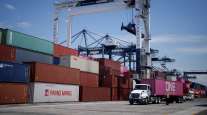U.S. Used Truck Exports Surging as Mexico Alters Laws, ACT Says
This story appears in the Sept. 23 print edition of Transport Topics.
Mexico has emerged as the hottest market for U.S. used truck exports this year, driven by regulatory changes in both countries and the improving Mexican economy, industry officials said.
Class 8 exports to Mexico are on track to reach 11,000 this year — a fivefold increase over 2012 — making up about 50% of all exports, according to ACT Research.
“Kind of a magical thing has happened,” said ACT President Kenny Vieth, who said Mexico’s truck import guidelines continue to be liberalized.
The latest liberalization took place earlier this year, when trucks more than 6 years old were allowed to be imported. Before, trucks had to be 8 or 10 years old, effectively limiting inventory.
Through the first seven months of 2013, ACT statistics showed that 36% of trucks manufactured in North America were built in Mexico. Most of those new trucks remained in the Mexican market, while about 12,000 new Class 8 units were exported to the United States. The balance of Mexican production was shipped to Canada and overseas.
Last year, Mexico accounted for 35% of Class 8 manufacturing.
Including Mexico, truck exports from the United States are expected to reach 21,900 this year, according to ACT. The increase in exports to Mexico compares with about 2,000 last year and about 1,000 the year before.
ACT estimates that 2014 used exports will drop about 15% because fewer trucks will be available after rising almost 45% from 15,200 last year.
Exports and other cross-border trucking are dictated by the North American Free Trade Agreement, which helped to build Mexico’s gross domestic product to nearly $1.2 trillion. Its GDP has gained nearly 60% since 2004 and risen in eight of the past nine years.
Mike Hayden, owner of export specialist Allstate Fleet & Equipment Sales in Houston told TT sales are rising for several reasons.
“There are very few used-truck dealers in Mexico,” he said Sept. 18. As the country’s economy improves, Hayden said, Mexican drivers who speak English increasingly are coming to U.S. outlets.
At the same time, Hayden said, the latest group of trucks allowed for export can run throughout Mexico. Older trucks are limited to the U.S. state where the owner registers it, he said.
“All of the changes have made it difficult for dealers,” Hayden said. “Mexico’s market is really hard to figure out.”
U.S. policy still bars Mexican fleets from running on U.S. roads outside a border zone, except for those accepted into the government’s pilot program.
As Mexico’s markets open, the California Air Resources Board is tightening regulations on older trucks, creating a natural market for equipment that won’t be able to run on California’s roads after Dec. 31, ACT Vice President Steve Tam told TT.
“There is an interest in California in moving any [pre-diesel-particulate filter] trucks out of the state,” said Steve Clough, CEO of used-truck dealer Arrow Truck Sales in Kansas City, Mo. “I would guess that a lot of trucks going into Mexico are coming from there.”
Clough also said that sales are having an effect on the U.S. market, where certain types of older equipment are desirable.
“There is still quite a demand”, he said, for 2007 models without a DPF and mileage in the 600,000 range. Newer trucks equipped with a DPF still are raising maintenance questions for some drivers seeking new equipment, he said.
Hayden also said exports to Mexico are having an effect on U.S. markets, particularly for what he called “fourth-generation” trucks that typically are sold for intermodal drayage.
Used-truck exports to Mexico have an average declared customs value of $16,000, Tam said.
Those buyers represent a totally different market from new truck buyers, he added, because of the large price disparity between old models and new ones, which can cost about $125,000.
One indicator of the sharp rise in demand is the fact that 400 units were exported to Mexico in January, and 1,100 were moved in July, Tam said. ACT bases used-truck forecasts on data from the International Trade Commission, a federal agency.
Stronger Mexican markets also are helping railroads, said Brian Bowers, vice president of Kansas City Southern, who spoke at an ACT conference Sept. 12.
“There is no more compelling story than nearshoring,” Bowers said, referring to increased Mexican manufacturing activity, such as new auto plants. The railroad’s intermodal
volumes doubled last year over 2011 and nearly equaled the full 2012 total in the first half of 2013.
Until this year, Nigeria led the export market, Tam said, because oil-field operators there snapped up older equipment.
A few years ago, Russia was the largest export truck market. Sales totaled about 6,000 units there in 2008 before plummeting to less than 1,000 after Russia altered trade policy to bar used-truck imports.
However, the Russian market continues to be accessible for new trucks.
For example, Navistar International Corp. on Sept. 9 said its ProStar equipped with a 13-liter engine is on sale in Russia. The equipment offers 430 horsepower and 1,550 pound-feet of torque.
“Customers in Russia require a reliable and durable truck that’s easy to maintain,” said Nurali Bunyatov, Navistar’s managing sales director for Russia and the Commonwealth of Independent States.




